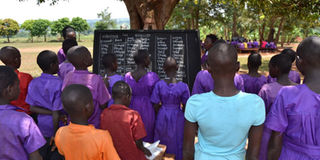Busoga keen to rein in pupil dropout rate

Some pupils of Bugomba Primary School in Luuka District study under a tree. Parents say the unconducive learning environment causes school dropout. PHOTO BY MUDANGHA KOLYANGHA
What you need to know:
- State actors insist that they are doing everything within their powers to course-correct. President Museveni shared some of the interventions being considered to make learning centres accessible to all learners.
- Nabirye, who was forced to leave the government-aided school in Iganga District, said her father saw no reason in keeping a girl between the four walls of a classroom. Besides, she further disclosed, he was choking on debts from a watering hole in the neighbourhood.
For some, Shs30,000 is pocket change. Not Joan Nabirye. The 16-year-old primary school dropout vividly remembers the day it felt like the sky fell.
“On one morning at my school, my teacher told me I could not sit for my final examinations if I did not complete a fee of Shs30,000 for the Universal Primary Education programme I was attending,” she told Monitor.
Nabirye, who was forced to leave the government-aided school in Iganga District, said her father saw no reason in keeping a girl between the four walls of a classroom. Besides, she further disclosed, he was choking on debts from a watering hole in the neighbourhood.
“This left me torn between two roads of an early marriage or a domestic worker. I chose the latter. The job itself would support me with a monthly pay of Shs50,000, almost half the amount I missed at a chance for a decent schooling and future,” Nabirye said, adding that insults her bosses hurled at her and even the odd rape attempt blighted any joy she had.
The travails that Nabirye is confronted with are common occurrences in Busoga Sub-region. It is estimated that 91 percent of children between the ages of 11 and 19 in Jinja District do not get to see blackboards in secondary schools. The Science Publishing Group, which carried out the research in 2019, noted in its report that such findings “call for high attention.”
The school dropout rate was attributed to a “high risk of low economic status even in adulthood due to unemployment, low paying jobs, alcoholism, [and] poor health, [among others].” The findings dovetail with those of the Uganda Bureau of Statistics that make clear the fact that children hailing from low income households in Busoga Sub-region are always handed a poisoned chalice.
“I was only 11 years old when my suitor, an averagely wealthy man in the village, lured my parents into a decision to marry me off. I was to be his third wife,” Constance Kantono, a resident of Buyala, Jinja District, told Monitor how an arranged marriage left her scarred for life.
Kantono was only three months shy of her first period when she was married off as her birth parents struggled to keep their heads above water.
“I was only a child,” she said, adding, “All I had were dreams for a future that would pull my family out of the grips of poverty.”
As a child herself, Kantono mothered other children and developed complications from early pregnancies that endangered her health.
State of affairs
Mr Adrian Ndemere, the national chairperson of Uganda Association of Private Vocational Institutions (UGAPRIVI), estimates that Busoga Sub-region has “about 60 government and private-owned educational institutions”.
He notes that the high costs of training and material in vocational institutions are a great hindrance to keeping children in school.
State actors insist that they are doing everything within their powers to course-correct. President Museveni shared some of the interventions being considered to make learning centres accessible to all learners. Speaking at his pre-79th birthday fete at Kololo Ceremonial Grounds on August 8, President Museveni said: “I was in Kyankwanzi with Maama Janet talking to the head teachers from eastern Uganda and I told them that the head teachers in government schools have been blocking our plan of free education for all. But now we are going to bring back that programme, I want children to study for free in government schools, Primary, secondary and technical schools.”
Mr Museveni added: “Education is not a business. Some people look at education as a business and money maker, but if you want these Bazzukulu (grandchildren) to have a bright future, principle number three in our ideological principles is social economic transformation.”
Capacity building
Mr Ndemere appreciates the relevance of vocation training in building skills among young people, hence reducing the prevalence of school dropouts in the region.
“Vocational institutions train children who have no skills and education in modular training of specific employable skills such as tailoring on a single machine to gain employment,” he told Monitor, adding that vocational training helps persons to progress not least because it gives them competencies.
He further said, “Even at Primary Seven, one is able to take on intuitional training and acquire skills and have a basic minimum to progress up to university education.”
This, he shares, is achieved through a training mechanism that entails progression levels.
“For children who drop out from primary level, they can study through different modules and progress through the different levels and acquire an equivalent of Senior Four, Senior Six and even a diploma, which takes up to three months, one year and a half and two years respectively,” he disclosed.
Mr Ndemere said the government has made strides in improving skilling among young people through different interventions.
“The Belgium government is coming in to support Busoga [Sub-]region through the Enabel initiative which is in plan for the financial year and the training is expected to benefit about 70,000 youth in the region,” he revealed.
The hope is that young girls in Busoga Sub-region will not suffer the fate that befell Nabirye.





